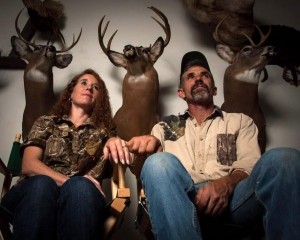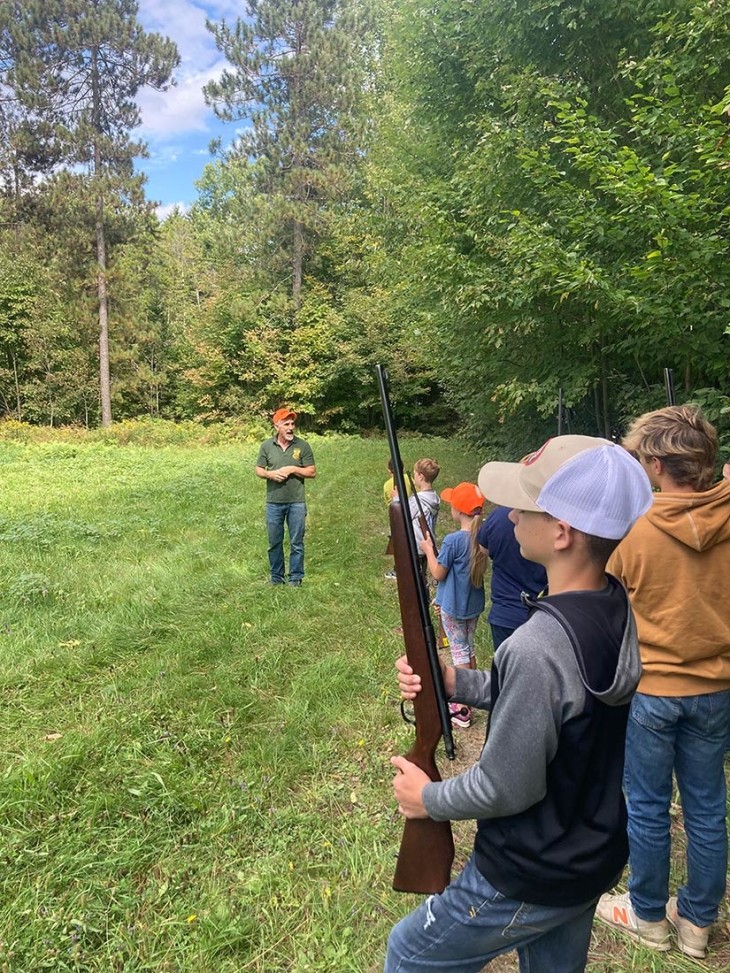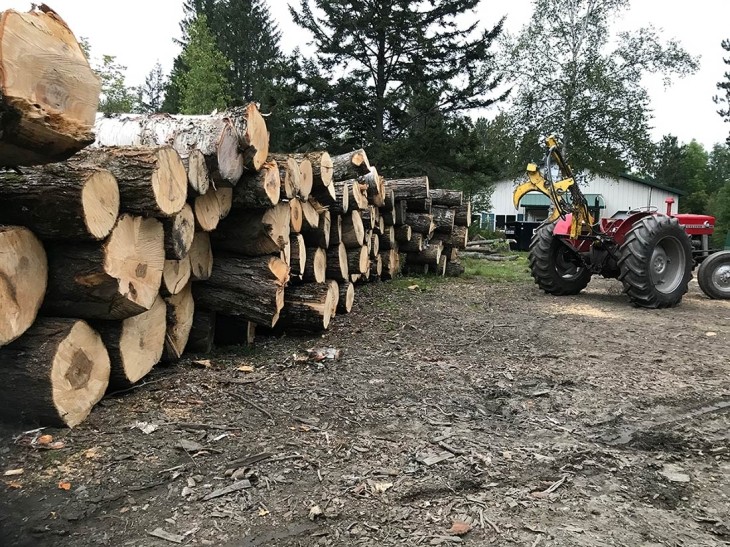Rodney Elmer has been chasing game through the forests of Vermont – and beyond – since he was a kid. He’s turned his passion for the woods and hunting into his life’s work – as a taxidermist, a hunter safety educator, and a social media personality. With his wife Teresa and their three sons, Rodney hosts the Mountain Deer Podcast, offers hunting “master classes,” and has a YouTube channel – all with an eye to inspire others to learn about and cherish the outdoors. He and Teresa live in Northfield, Vermont.
My family is from Orange, which is about a half hour or so from where we live now. Both Theresa’s family and my family have been in Vermont for a long time – our boys would be 10 generations. That’s since before Vermont was Vermont. Vermont’s just kind of this nice, soft, easy place to be. We’ve traveled everywhere. A lot of the family has moved to other places. But it’s a little easier going, and it’s nice here. I don’t blame everybody for wanting a little piece of it.
If I wasn’t in a meadow or chasing brook trout as a kid, I was up in the woods running after squirrels or something. I spent a fair amount of time farming, too. Most of Vermont then was basically farms. Everyone had a sugarbush where they made their syrup, and you farmed the rest of it. We had beef cows. My next door neighbor had a big dairy and I worked for him, mostly running tractors, haying, stuff like that. And I cut millions of cords of firewood for my grandparents and uncles and aunts. Spent plenty of time in the woods hunting and plenty of time just in the outdoors in general. I kind of took it for granted. All the things about nature that lots of people are just learning now as adults, we learned all that stuff as kids.
Being in touch with the woods and being a kid on a farm, the hunting came natural. We saw lots of wildlife, we knew where it was because we were on the landscape all the time. My dad and my grandfather never really hunted much. They were too busy working all the time. But I was intrigued by the deer. I’d sneak up on the deer in the summertime and watch them and maybe take some pictures of them. I got into archery and starting bow hunting some. Eventually I got more into hunting, and I had boys of my own and introduced them to the woods and all of the good things the woods have to offer for a young person growing up. It ended up turning into this craziness of being a taxidermist, and the boys talked me into having a YouTube channel. Then the podcast thing came along. You end up sharing your experiences. That’s what we do: we bear witness to what we know.
Deer hunting ended up being my vacation every fall. I’d get to be alone and go out in the woods and get back in touch and let some of the craziness of regular life fade away a little bit. And I wanted the boys to be able to go into the woods anywhere at any time and be able to navigate and know how to survive and to understand all of the things that nature has to offer. Hopefully in the end, that helps pass on that caring about the land. Kids are the ultimate scientists. Their curiosity about things and their wonder need to be nurtured, and hopefully they’ll maintain that throughout their lives.
When I was young, I went caribou hunting in Quebec once, before the dams ruined the Quebec herd. I wish the boys could have been there to watch the ground move as far as the eye could see. It’s really something. When I came back from my caribou hunt, I wanted to get the animal mounted. I walked into the taxidermist’s shop – Matt Renaud up in Colchester – and looked at all of his stuff, and I thought, “This is so cool, I’ve got to give it a try.”
I’m a duct tape and staples kind of guy. I’ll give anything a try. In Field & Stream magazine, one of the taxidermy supply companies was advertising a deer kit where you could buy a kit with all the pieces and parts you needed. And when you got a deer, you’d just skin it, flesh it and salt it and tan it. You’d buy a mannequin that fit the size of your deer. I figured I didn’t have anything to lose. So, I bought the kit, followed the instructions. That first deer mount took four or five days down in my basement, messing around, but I finally got it done. I’m willing to learn and do things and go after what I like doing.
Now I’ve been doing taxidermy for 38 or 39 years. And I’ve gotten to know a lot of hunters, gotten to talk to a lot of people, been to a million Fish & Wildlife meetings. After that first deer, I got a few VHS videos about taxidermy. I also went to the United Taxidermists of New York’s annual meet, where taxidermists get together, and you can enter your work in a competition. They tell you how to fix it, make it look better. You can get ideas about different ways to do something and get creative. I’ve probably met half a million people over the years, at least. The YouTube and the social media stuff has really turned that up as well. You get to discuss so much with so many people. You get a pulse on the culture and what people’s feelings are.
Taxidermy is almost like sculpting, in a way. You’re building a three-dimensional picture. That’s the point – to have the good feelings and the memories be on the wall, and when you look at it, you get those out of it. Memories fade just a whisker, but if you have something physical to look at, the feeling and portrayal of where you’ve been is there. There’s plenty of reasons people want a mount of something. There’s plenty of chances for an ego or something to be connected to a thing. But I hang them on the wall to say, “I was part of that.” I was there. I was part of something greater than I am.
Teresa and I have been teaching hunter safety for almost 20 years now. To purchase a hunting license, you need to go through hunter safety training through the state. We teach proper gun handling – loading and unloading. Where the best places to shoot or not shoot are. Also the people’s ownership of the public trust resource, and the governance and guidelines of how to treat that resource. It teaches how that all blends together. One of my friends was an instructor, and I helped him a few times, then became an instructor myself. Theresa and I both started doing it, and the boys eventually became instructors as well.
The Mountain Deer stuff is like a more advanced school. As you go out, and you start hunting a little bit, you may need some extra knowledge about things. When I was young, I had not only the magazines and the stories at deer camp from everybody else, but I also had my own experiences. I just snowballed them all and learned, and picked up little pieces as I went. Now, there’s so much that you can learn from so many people from all over the world. That empowers people to be able to go out and do it. Over time, it’s been a great way to learn, advance yourself, and understand a lot about things – and then be able to wisely use all those things. That’s what the word conservation is, right? The wise use of a resource. And it helps people get to that point where they not only wisely love the world, but also take care of it.
I also spend a fair amount of time logging on my own land. I have about 100 acres, and I get the most that I can from my land and try to make it the most it can be. Maybe that’s a little bit of the farmer in us, we want to optimize everything. Our forest is mostly mixed hardwood and softwood. It was part of a registered deer yard at one time. It has a southeastern exposure with a little bit of western exposure. It has some shelving on it, and it’s tucked out of the wind a little bit, which is all ingredients for deer to yard there. I’ve been taking the hardwoods out around the hemlocks and trying to encourage any softwood to grow. I like to mix the fir with a lot of red spruce, because it has a longer lifespan, it grows a bit slower, but it will also last longer than the fir will. And it needs the fir as company to really grown well. The baby hemlocks and the baby cedars – the deer just eat them all.
I stay right after my hardwoods, because that’s what Vermont grows. You’ll get billions of stems if you just let the sunlight in. I keep cutting those. I try to look up a lot as I’m holding my chainsaw and decide what I want to keep. I try to have leaves going all the way from the forest floor to the ceiling so that my woods are thick. I try to leave them messy. I like blowdowns and root balls. I don’t clean it all up like a park. I want that chickadee to have a place to fly into when the hawk is chasing it. I want that baby bunny to have a place to hide out and get away from the coyotes.
I do my best to keep the invasives out of my forest. I don’t connect my roads to the main highway. I try to maintain shade around my logging roads, especially where they enter or exit the woods, because it helps keep the invasives down. I keep the landings hard and back away from the road. I mow the outside of it. The areas I do want light in, I try to cut them so that they get enough light, and I also try to disturb the duff enough so that seeds and suckers from the roots will start growing and get ahead of the invasives. I don’t use chemicals. I mow my own 3,000 feet of road frontage – I don’t let the town do it. I maintain it all myself, because I just don’t want any of that stuff to be in my forest any faster than it’s going to on its own.
I enjoy our forests so much, and I would encourage everyone else to do the same. To think that the world is doomed, I think, makes you not on the team to save it. You have to have a positive outlook. Getting in the right frame of mind to do the right thing and to feel the right way about it helps makes things come true. If we base it on a love and a willingness to do, we’ll do a great job on things – that’s when you do your best work. If you base everything on fear, that will bring its own troubles. I’ve just always wanted to do my best to share a good attitude. I don’t want to see myself as part of a doomed world. I want to see myself as part of an evolutionary world, where things are getting better, where things can improve.





